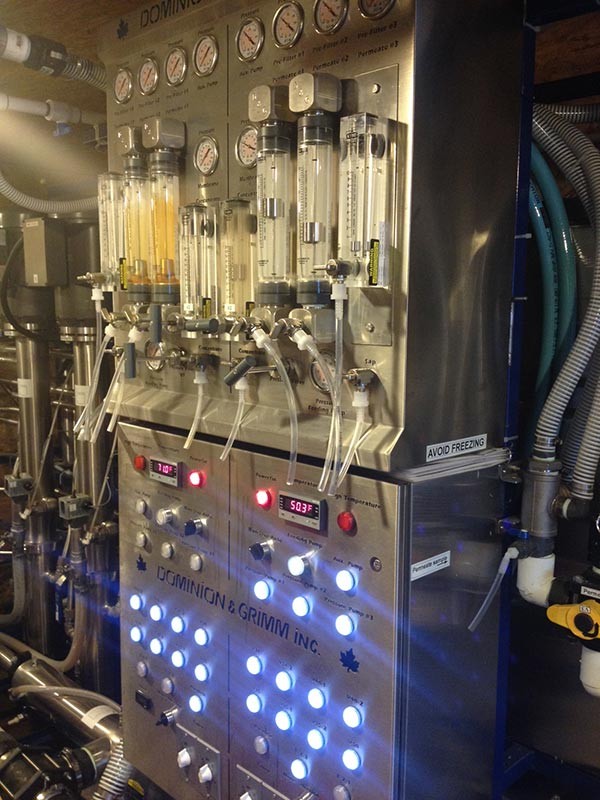We had our annual maple open house weekend last weekend, and at one point a group of older women stopped by and visited – told us stories of the sugaring they grew up with. “Lot more work back then,” one said, and in ways she’s right. Whereas my grandfather slogged around on snowshoes collecting every drop of sap by hand, I sit at home editing in the morning while the sap moves through lines and pools in a collection tank. While my grandfather boiled through the night on heavy runs, we simply adjust a knob on the RO and squeeze the sap harder – it’s rare that we ever boil for more than eight hours at a time.
But I don’t think today’s sugaring is any less work if you consider the trajectory of the whole season. Sixty years ago, our sugaring forefathers and mothers often thought about sugaring for the first time on March 1 as they walked out to the barn where the sap buckets were stored. About the only mechanical aptitude they needed was to know how to solder a hole in a bucket or a pan. They worked hard for a month, or if they were lucky six weeks, but then they were done and their syrup was sold in time to start working the fields. Today, most sizable operators are maintaining their tubing infrastructure throughout the year. They’re starting their woods work by January 1, and on years like this it’s still a mad rush to get tapped in time. Vacuum systems only work when there are no leaks, which means you’re still walking tree to tree every run, albeit carrying tubing repair supplies instead of sap. Today, you’d better know how to fix a hole in a bucket, but also troubleshoot a vacuum pump and releaser, and you’d do well to at least have a working understanding of your $30,000, or $50,000, or $100,000 reverse osmosis machine because when something inevitably fails the handful of service techs are going to inevitably be busy with someone else’s issue and your season could be on the line.
We sold a lot of sap this year rather than boiling it ourselves on account of some family medical issues and some poor timing related to my family planning. There were nights in the early part of the season when we’d visit with the guys at the sugaring operation up the road as we brought in loads of sap. “How’s the battle?” we’d say, and they’d say things like “the vac’s down in the Sandgate bush,” or “the back axle went in the second truck,” or “we hauled our last load at 3 [a.m.] last night.” That’s if we spoke at all – plenty of nights we’d sit and watch the sap drain from our truck tanks while they sat slumped on syrup drums watching sap boil, all of us too tired to make conversation.
None of this should be taken as a complaint – there’s nothing I’d rather have been doing the last three months and they’d say the same thing. The point is just to reflect on our tendency to view technology as a means of simplifying life, when often it does just the opposite. Technology has made sugaring, and logging, and name-your-trade physically easier than it used to be, for sure, but it can also lull you into a false idea of all the things you might accomplish, which can make things harder in the end.
Another visitor at the open house was a guy from Utah – friendly, earnest fellow – who bought a 70-acre, high-elevation Vermont woodlot in a snowbelt town with the idea that he’s going to put in 3,000 taps and fly east every spring to sugar it. The land slopes away from the road so he’s figuring out the logistics of pumping the sap 500 feet in elevation to a collection tank in an area without power, then it’ll be on to the logistics of the sugarhouse and sap processing and a place for him to sleep. We smiled and nodded and chipped in with some hopefully helpful suggestions; there was something so wonderfully American about his can-do spirit, and the idea was no more harebrained than some of our own. It might actually work. But I couldn’t help but wonder if this was an egregious case of tech seduction. There’s a technological solution to every one of his logistical roadblocks – from a plane to fly him across the country, to a pump that will transfer his sap, to a generator that will solve his power issues. But there’s not a product out there that can control the weather or the physiology of the trees, which in the end is still what makes or breaks a season. There’s no app that will add hours to a day or capital to the emotional bank accounts we share with our loved ones, all of which can seem in short supply as the season slogs on.
If I imagine my grandfather looking down from heaven at the way sugaring is being practiced these days, I’m not sure he’d be thinking how much easier it all seemed. I kind of think he’d be muttering: “these people are nuts.”



Discussion *